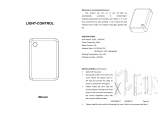2 – English
GENERAL WARNINGS: SAFETY - INSTALLATION - USE (original instructions in Italian)
The following warnings are taken directly from the Regulations and apply, as far as possible, to the product described herein
CAUTION Important safety instructions. Observe all the instructions as improper installation may cause serious damage
CAUTION Important safety instructions. It is important to comply with these instructions to ensure personal safety. Store
these instructions
•Before commencing the installation, check the “Product technical specications”, in particular whether this product is suitable for automating
your guided part. Should it be unsuitable, DO NOT proceed with the installation
•The product cannot be used before it has been commissioned as specied in the “Testing and commissioning” chapter
CAUTION According to the most recent European legislation, the implementation of an automation system must comply with
the harmonised standards set forth in the Machinery Directive in force, which allow for declaring the presumed
conformity of the automation. On account of this, all operations regarding connection to the mains electricity, as
well as product testing, commissioning and maintenance, must be performed exclusively by a qualied and skilled
technician!
•Before proceeding with the product’s installation, check that all materials are in good working order and are suitable for the intended applications
•The product is not intended for use by persons (including children) with reduced physical, sensory or mental capacities, nor by anyone lacking
sufcient experience or familiarity with the product
•Children must not play with the appliance
•Do not allow children to play with the control devices of the product. Keep the remote controls out of reach of children
CAUTION In order to avoid any danger from inadvertent resetting of the thermal cut-off device, this appliance must not be powered
through an external switching device, such as a timer, or connected to a supply that is regularly powered or switched off by
the circuit
•Provide a disconnection device (not supplied) in the plant’s mains power supply, with a contact opening distance that ensures complete
disconnection under the conditions envisaged by Overvoltage Category III
•Handle the product with care during installation, taking care to avoid crushing, knocks, falls or contact with liquids of any kind. Keep the
product away from sources of heat and open ames. Failure to observe the above can damage the product and increase the risk of danger
or malfunctions. If this should happen, stop installation immediately and contact the Customer Service
•The manufacturer assumes no liability for damage to property, items or persons resulting from non-compliance with the assembly instructions.
In such cases the warranty does not cover material defects
•The weighted sound pressure level of the emission A is lower than 70 dB(A)
•Cleaning and maintenance to be carried out by the user must not be effected by unsupervised children
•Before intervening on the system (maintenance, cleaning), always disconnect the product from the mains power supply
•Check the system periodically, in particular all cables, springs and supports to detect possible imbalances, signs of wear or damage. Do not
use the product if repairs or adjustments are necessary, since an installation failure or an incorrectly balanced door may cause injury
•The packaging materials of the product must be disposed of in compliance with local regulations
•Keep persons away from the gate when it is moved through the control elements
•When performing a manoeuvre, keep an eye on the automated mechanism and keep all bystanders at a safe distance until the movement
has been completed
•Do not operate the automation if anyone is working on it; disconnect the power supply before permitting any work to be carried out
•If the power cable is damaged, it must be replaced by the manufacturer or by the latter’s technical assistance service, or by a similarly qualied
person, in order to prevent any type of risk
INSTALLATION PRECAUTIONS
•Prior to installing the drive motor, check that all mechanical components are in good working order and properly balanced, and that the au-
tomation moves correctly
•If the gate or door being automated has a pedestrian gate, then the system must include a control device that will inhibit the operation of the
motor when the pedestrian gate is open
•Make sure that the control devices are kept far from moving parts but nonetheless in a visible position.
Unless a selector is used, the control devices must be installed at a height of at least 1.5 m and must not be accessible
•That windows, having a gap exceeding 200 mm when open, are to be closed using a biased-off switch if the opening movement is controlled
by a re-sensing system
•Ensure that entrapment between the driven part and the surrounding xed parts due to the opening movement of the driven part is avoided
•Permanently x the label concerning the manual release adjacent to its actuating member
•After installing the drive motor, make sure that the mechanism, protective system and all manual manoeuvres operate properly






















